Hendrik van Balen the Elder stands as a significant figure in the rich tapestry of Flemish Baroque painting. Active during the late 16th and early 17th centuries, a period of immense artistic flourishing in Antwerp, Van Balen carved a distinct niche for himself. He was celebrated for his refined mythological and religious scenes, often executed on a small scale, and became particularly renowned for his frequent and fruitful collaborations with other leading artists of his time. His role as a respected teacher further cemented his influence on the Antwerp school. His confirmed lifespan, from his birth in 1575 to his death in 1632, places him squarely amidst contemporaries like Peter Paul Rubens and Jan Brueghel the Elder, with whom he shared personal and professional ties.
Formative Years in Antwerp
Hendrik van Balen was born in Antwerp, the bustling artistic and commercial heart of the Southern Netherlands, in 1575. Sources suggest he came from a prosperous background; his father was reportedly a merchant, indicating a family familiar with commerce and likely able to support his artistic education. While definitive documentation is scarce, art historians propose that Van Balen received his initial training from either Adam van Noort or Marten de Vos. Both were prominent painters in Antwerp, and Adam van Noort is also famously known for having taught other luminaries such as Peter Paul Rubens and Jacob Jordaens. Regardless of his specific master, Van Balen absorbed the prevailing artistic currents of late 16th-century Antwerp.
By 1592 or 1593, Van Balen had achieved the status of a master painter, formally enrolling in the prestigious Antwerp Guild of Saint Luke. This membership was essential for any artist wishing to practice independently, take on apprentices, or sell their work within the city. His acceptance into the guild marked the official commencement of a long and successful professional career spent largely within his native city.
The Italian Sojourn and Venetian Influence
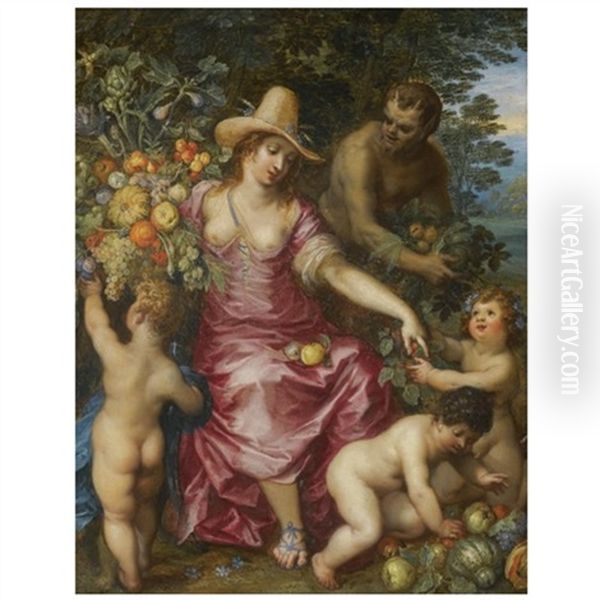
Like many ambitious Northern European artists of his era, Van Balen undertook a journey to Italy to study classical antiquity and the masters of the Italian Renaissance and Baroque. This formative trip likely occurred between the mid-1590s and around 1600. While details of his itinerary are not fully documented, it is evident that his time in Italy, particularly his exposure to the Venetian School, left a lasting impression on his artistic development.
The influence of Venetian painters such as Titian, Tintoretto, and Veronese can be discerned in Van Balen's work, especially in his earlier paintings. This is noticeable in his richer color palettes, the softer modeling of figures, and a certain elegance in composition. He may have spent time in Rome as well, absorbing the classical atmosphere and the works of contemporary Roman artists. His connection to Italy was later reaffirmed by his membership in the Confraternity of Romanists in Antwerp, a society for artists, dignitaries, and humanists who had visited Rome, which he reportedly joined around 1605.
Establishing a Leading Workshop in Antwerp
Upon returning to Antwerp around the turn of the century, Hendrik van Balen established his own workshop. His talent and the polish gained from his Italian studies quickly brought him recognition. Records indicate he began formally accepting apprentices around 1602-1603, signaling the growth and success of his studio. Over the course of his career, his workshop became one of the leading artistic enterprises in Antwerp, known for producing high-quality paintings.
Van Balen's standing within the Antwerp artistic community is further evidenced by his active role in the Guild of Saint Luke. He served as the second dean of the guild for several terms between 1608 and 1612, and subsequently held the prestigious position of head dean, likely around 1609-1610 or 1613 according to varying sources. These leadership roles underscore his respectability and influence among his peers. His workshop was not only a place of production but also a significant training ground for the next generation of artists.
Hallmarks of Van Balen's Artistic Style
Hendrik van Balen developed a distinctive style characterized by refinement, clarity, and a preference for certain themes and formats. He specialized in 'cabinet paintings' – small, finely executed works intended for private collectors and intimate viewing. His preferred supports were often copper plates or wooden panels, surfaces that allowed for a high degree of detail and a smooth, enamel-like finish.
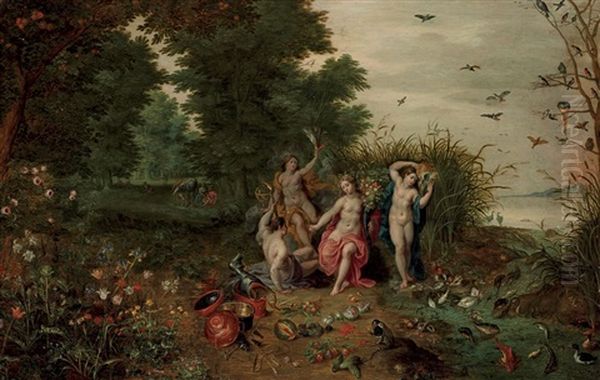
His subject matter frequently drew from classical mythology, Ovid's Metamorphoses being a rich source, depicting gods, goddesses, nymphs, and mythological events. Religious themes, including biblical narratives, scenes from the lives of saints, and depictions of the Holy Family, also formed a significant part of his oeuvre. Allegorical subjects were another common choice. A defining feature of his work is his skill in rendering the human figure, often depicted with elegance, anatomical accuracy, and smooth flesh tones. Nude or semi-nude figures feature prominently in his mythological scenes.
His drawing is typically precise and confident, with clear outlines defining forms. While influenced by the rich colors of Venice early on, his palette often employed bright, clear hues, sometimes with strong local colors, contributing to the decorative quality of his work. His style, while distinct, shows an awareness of the broader developments in Flemish Baroque, including the dynamism introduced by his contemporary, Peter Paul Rubens, although Van Balen generally maintained a more restrained and classical elegance.
The Art of Collaboration: A Defining Feature
Collaboration between specialist artists was a hallmark of Antwerp painting in the 17th century, and Hendrik van Balen was a master practitioner of this mode of production. His primary expertise lay in figure painting, and he frequently partnered with artists who specialized in landscapes, still lifes, or architectural settings. This allowed for the creation of works that combined the highest level of skill in different areas, appealing to discerning collectors.
These collaborations were not merely commercial arrangements; they often stemmed from friendships and mutual respect among artists. Van Balen's ability to seamlessly integrate his elegant figures into the compositions of others made him a sought-after partner. This practice significantly expanded his output and reach, contributing to the diversity of works associated with his name.
Partnership with Jan Brueghel the Elder
Van Balen's most famous and enduring collaboration was with Jan Brueghel the Elder, nicknamed 'Velvet' Brueghel for his refined technique. Brueghel was a master of landscape and still life, known for his meticulous detail and vibrant depictions of nature, flowers, and animals. Together, Van Balen and Brueghel created numerous masterpieces that perfectly blended their respective talents.
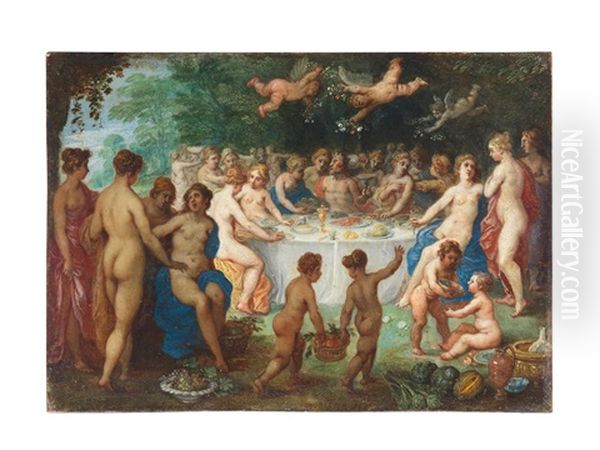
In these joint works, Brueghel typically painted the lush landscapes, detailed floral arrangements, or abundant still life elements, while Van Balen added the mythological or allegorical figures that populated these scenes. Famous examples include series like The Four Seasons (with Spring often cited as a highlight) and The Allegory of the Four Elements. Their collaborative Feast of the Gods or Wedding of Peleus and Thetis paintings are celebrated for their intricate detail and harmonious fusion of landscape and figure painting. This partnership was built on a strong personal friendship as well as artistic synergy.
Continuing the Legacy: Jan Brueghel the Younger
After the death of Jan Brueghel the Elder in 1625, Hendrik van Balen continued to collaborate with his son, Jan Brueghel the Younger. Jan the Younger took over his father's successful workshop and largely continued his style and thematic concerns. He stepped into his father's role in the partnership with Van Balen, ensuring the continued production of popular collaborative works.
Examples of their joint efforts include paintings on themes like the Five Senses and biblical scenes such as The Massacre of the Innocents, where Brueghel the Younger would provide the detailed setting and Van Balen the dramatic figures. This continuation demonstrates the strength of the workshop traditions and the established demand for these types of collaborative paintings in the Antwerp art market.
Diverse Artistic Alliances
Beyond the Brueghels, Hendrik van Balen collaborated with a range of other specialists. He worked with Frans Snyders, a leading painter of animals and still lifes, likely adding figures to Snyders' market scenes or elaborate arrangements of game and produce. Collaboration with landscape specialists like Joos de Momper is also highly probable, with Van Balen providing the staffage (small figures) that animated Momper's expansive mountain or winter landscapes.
Sources also mention collaborations with artists like the Franckens family, particularly Frans Francken the Younger, known for cabinet paintings often featuring historical or allegorical scenes. Van Balen is noted to have worked with Franckens on furniture paintings, decorating cabinets with religious and mythological narratives. Less famous collaborators named in sources include Jan van Steenwen and Francis Polen van den Bogaert, further illustrating the breadth of Van Balen's network within the Antwerp art world.
Survey of Key Works
Hendrik van Balen's oeuvre includes numerous works that exemplify his style and thematic preoccupations. Diana and her Nymphs Hunting or similar scenes featuring the goddess Diana were popular mythological subjects, allowing Van Balen to showcase his skill in depicting elegant female nudes within a landscape setting (often provided by a collaborator).
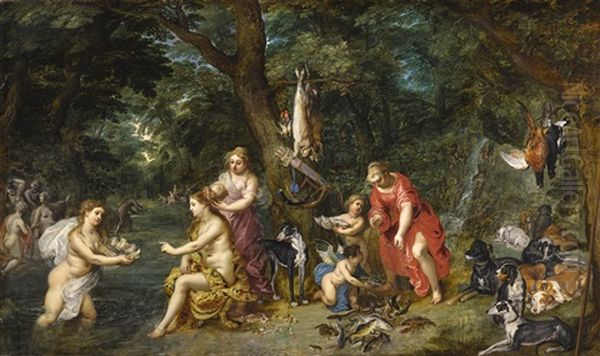
The Gift of the Sea (or similar titles featuring Neptune/Poseidon and Amphitrite) provided opportunities to depict mythological abundance and marine deities, often with rich allegorical undertones. Works like Moses Striking the Rock, frequently painted on copper, demonstrate his handling of religious narratives, requiring the depiction of numerous figures in dramatic interaction within a landscape context.
Paintings such as The Madonna and Child with the Infant Saint John, Surrounded by Animals highlight his ability to integrate serene religious figures into detailed natural settings, likely painted in collaboration with an animal or landscape specialist like Jan Brueghel. Grand mythological gatherings like The Wedding of Peleus and Thetis or The Feast of the Gods represent the pinnacle of his collaborative efforts, often involving Jan Brueghel the Elder, showcasing dozens of figures amidst opulent natural or divine settings.
A Respected Teacher and His Influence
Hendrik van Balen was not only a successful painter but also a highly respected and influential teacher. His thriving workshop attracted numerous pupils eager to learn his refined style and technique. His most famous students were undoubtedly Anthony van Dyck and Frans Snyders, both of whom became leading masters of the Flemish Baroque in their own right.
Anthony van Dyck, who later achieved international fame as a portraitist, spent time in Van Balen's studio in his youth before moving on to become Rubens' chief assistant. Frans Snyders, already mentioned as a collaborator, also trained with Van Balen, honing his skills before specializing in animal and still life painting. The fact that Van Balen trained artists of such caliber speaks volumes about the quality of instruction and the reputation of his workshop. His influence extended through his many students, shaping the course of Antwerp painting.
Success, Status, and Scholarly Pursuits
Hendrik van Balen's career was marked by considerable professional success and financial prosperity. His paintings were sought after by collectors both locally and internationally. His status is reflected in his ability to purchase a larger house in Antwerp in 1622. Furthermore, inventories compiled after his death reveal that he possessed a substantial personal collection of art, including numerous paintings and sculptures, indicating not only wealth but also a discerning eye and engagement with the broader art world.
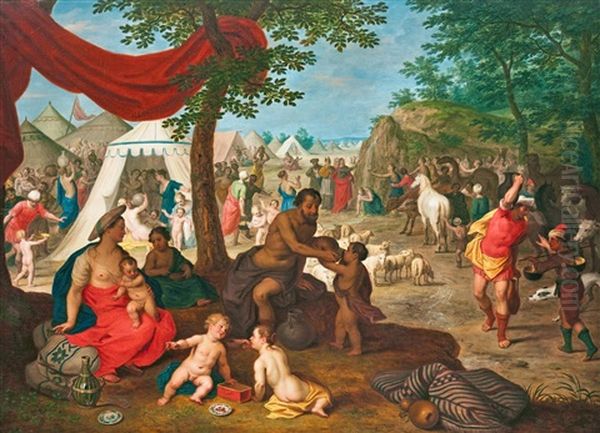
Anecdotal evidence suggests Van Balen was also a man of some learning. He was reportedly multilingual, proficient in Latin, Dutch, French, and Italian. This linguistic skill would have been advantageous for his travels in Italy and for dealing with international patrons and colleagues. His works found their way into prestigious collections across Europe, with mentions of pieces owned by figures as prominent as the Pope in Rome and the King of Spain, attesting to his international reputation. While his style was distinct, his high quality sometimes led to his works being occasionally misattributed to his more famous contemporary, Peter Paul Rubens, a testament to the esteem in which his art was held.
Enduring Legacy
Hendrik van Balen the Elder occupies an important place in the history of Flemish art. He excelled as a painter of elegant figures, particularly within the popular genres of mythology and religious allegory. His mastery of the small-scale cabinet painting, often on copper, contributed significantly to this format's popularity. Perhaps most distinctively, he stands out as one of the most prolific and successful collaborators of his time, his partnerships, especially with Jan Brueghel the Elder, producing some of the most cherished works of the Antwerp school.
As an influential teacher, he played a crucial role in nurturing the talents of major artists like Anthony van Dyck and Frans Snyders. His refined style, characterized by clear drawing, bright colors, and graceful figures, offered a distinct alternative to the more robust dynamism of Rubens, contributing to the diversity of the Flemish Baroque. Today, his works are held in major museums worldwide, including the Louvre in Paris and the Rijksmuseum in Amsterdam, ensuring his continued recognition as a key figure of Antwerp's golden age of painting.
Conclusion
Hendrik van Balen the Elder (1575-1632) was a versatile and highly skilled Flemish Baroque painter based in Antwerp. He distinguished himself through his elegant depictions of mythological and religious subjects, often executed with meticulous detail on copper or panel. His career was significantly defined by his extensive collaborations with other specialist masters, most notably Jan Brueghel the Elder and Younger, resulting in harmonious compositions that combined exquisite figures with detailed landscapes or still lifes. Furthermore, as the teacher of renowned artists like Anthony van Dyck and Frans Snyders, Van Balen exerted a considerable influence on the development of Flemish art. His professional success, respected status within the Guild of Saint Luke, and the enduring appeal of his refined artworks solidify his position as a central and accomplished figure in the Antwerp art scene of the early 17th century.